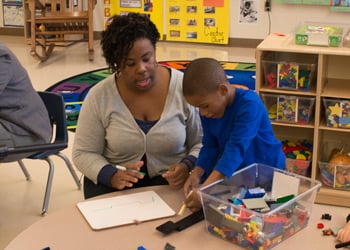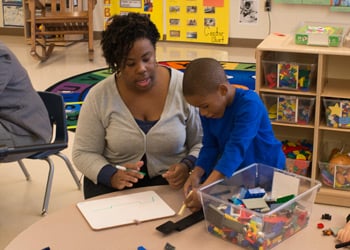

Here at Teachstone, we know that Concept Development is tricky to code, so we’ve put together a few tips to help you accurately measure it in the classrooms you observe.
Look for frequency, depth, and duration.
The most common coding error we see is a tendency to over-code. It’s an easy mistake to make. I know I get excited when I see a teacher using an experiment to get children thinking! But take a closer look: How many opportunities does the teacher actually provide for children to analyze and reason? How much depth is there to those opportunities? And how long does the opportunity last? When you look closer at the experiment, you might see that the teacher mainly asks prediction questions that she answers herself or that don’t really spark deep thought (“Will it turn purple or green when we mix them together? Green, right?”). Or she might make a passing reference to a similar experiment (“Remember when we mixed up glop and added food coloring?”) that isn’t explicit enough to help the children connect the concept of how colors are made. So, take a close look at your manual and really evaluate your evidence to avoid the tendency to over-code!
Remember that creating is about more than art projects!
Sometimes people code creative projects—sculpture, painting, and collage—as effective evidence of the creating indicator. These are great activities, but may not always stimulate children’s thinking, such as when they’re gluing circles on paper because the teacher wants them to know their shapes. So, what’s the difference? The manual says to look for “many opportunities to stimulate students’ creativity and ability to generate new ideas,” so we want to see evidence not just that the children are doing creative things, but that the teacher is getting them to come up with lots of ideas and to plan how they would follow through on those ideas. We’d want to see the teacher asking children lots of question such as “What should we make?” and “How should we do it?”—and to continue to really push children to come up with lots of different ideas for what to make and how to go about making it. And most likely the end products would look different from each other since there’s no one right way to make a TV show or paint a picture.
Recognize integration and connections to the real world.
Integration and connections to the real world are different indicators that can be easy to confuse. Integration is about intentionally linking together concepts across the curriculum and throughout the day so that children connect ideas—it generally takes place over time. Connections to the real world is about relating concepts and activities to children’s everyday experiences so that they’re meaningful. For example, if a teacher sets up a marble run station, she might ask about how raising and lowering the ramp will affect how fast the marble will go. To relate that to children’s lives, she might ask them to think about the balls on the playground and where they roll fastest. Later, when they’re on the playground, she might integrate the marble activity to their ball play, asking them about how they can take what they learned in their marble play to make the balls roll faster or slower, why the ball rolls faster on the steep slope and only slowly on the field, and what else rolls faster on the slope—their bikes? hoola hoops? what about eggs?—all examples the children can relate to. This really stimulates their thinking, forging connections and helping them build an understanding of the world.
Look for explicit evidence!
It can be easy as coders to pick up on a teacher’s intention and think the children do, too. Of course she’s reading a book about butterflies with the children and has a butterfly hatching kit because these activities are related to the concept of metamorphosis. But has she made that clear to the children? Do they “get” that the metamorphosis they’re reading about relates to the chrysalis they’ve been observing in the butterfly habitat? Unless a teacher is explicit, that link won’t be clear and so can’t count as evidence of integration. So look for ways the teacher makes these connections concrete, through comments, questions, and discussions.
Keep learning.
I read through the manual several times while writing this post, and checked with a few experts as well (thank you, Nikki Croasdale and Sarah Hadden!). You can keep growing your knowledge, too. Check out our Observer Tips e-book for more info—and our CLASS Calibration webinars to help keep your coding skills fresh.
